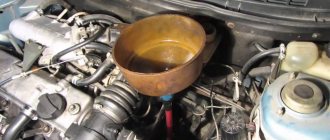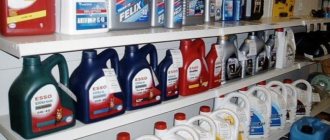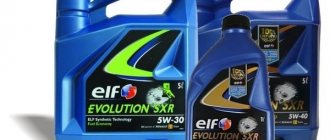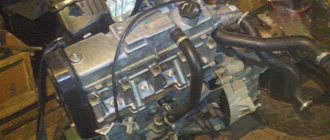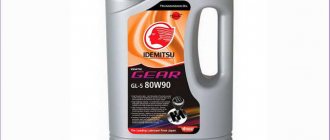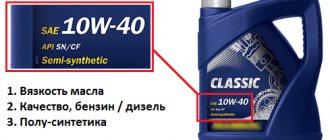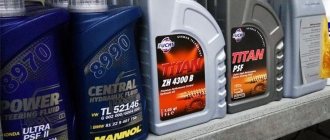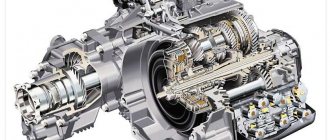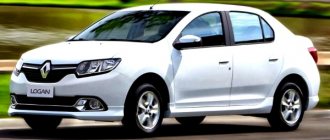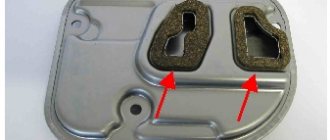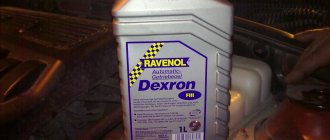The compact car from the French manufacturer PSA has been produced since 2007. Since 2013, production of the second generation of cars has been underway. It is equipped with both gasoline and diesel power units. These are the well-known 1.4 and 1.6 liter VTi, 1.6 liter THP, as well as the 1.6 HDi diesel. Boost level from 92 (diesel) to 150 horsepower (1.6 liter gasoline engine). What oil should I use for the Peugeot 308 engine? We will talk about tolerances, viscosity and recommended brands in this material.
- 5FS-9, 5FE-J, N6A-C, EP6, EP6C, EP6DT, EP6CDT
In 2009, PSA introduced its own oil approvals for Peugeot-Citroen cars. But there are no 100% special materials specifically for Peugeot-Citroen, there is a general set of requirements that it must meet. Tolerances are based on ACEA specifications with some PSA requirements.
The car manufacturer's recommendations can be found in the car's operating instructions:
What kind of engine oil to pour into the EP6 Peugeot 308 engine
Many motorists are interested in what kind of engine oil to pour into the EP6 engine, which is considered one of the most common on our market. First, let's find out what kind of power unit this is. This is an EP6 1.6 VTI 16V, belonging to the “Prince” engine family, which has doomed us and other countries into disrepute. The engine was created jointly by BMW and PSA engineers.
This engine is known for being excessively sensitive to gasoline and oil; a huge number of motorists point to oil burns, and it appears even at low mileage. The reason is usually the occurrence of rings, wear of valve stem seals. To prevent this, you should use high-quality motor oils and refuel at proven gas stations. When choosing technical fluid for EP6, focus on modern and tight tolerances.
Any 5W-30 quality motor oil will do:
- LIQUI MOLY Top Tec 4300 5W-30
- WOLF Official Tech 5W-30 C3
- LIQUI MOLY Top Tec 4200
- MOBIL 1 ESP Formula 5W-30
Criteria for selecting the necessary materials
Engine lubrication
To eliminate the occurrence of unforeseen emergency situations during engine operation, to increase the power of the Peugeot 308 120 VTi, it is necessary to determine the required level of lubrication and determine the quality of gasoline consumption, you must always take into account several basic rules:
- The most suitable summer option for the Peugeot 308 120 VTi is LUXE HIT Mobil, Castrol 5W40. During the period of winter cold, the engine's performance level is given by oil of the same color 30;
- The purchase of food products increases only from sick registered representatives of manufacturers, since the car owner can always pour frequency counterfeit into the Peugeot 308 engine;
- The more mileage the Peugeot 308 120 VTi has, the faster it eats up the lubricant and, therefore, the higher its viscosity should be, compared to the recommendations of the car developers. It is unusual to pour the same fluid into an old engine as in a new one;
- When it is known which engine oil the driver should pour into his Peugeot after using another product of the brand, it is recommended to use a preliminary application of lubricating oil flush.
Engine oil consumption
The reason for increased oil consumption is often discussed among Peugeot 308 owners. The engine overuses lubricant especially actively as mileage increases.
Messages like this are quite common:
“I have a Peugeot 308 from 2008. Under the hood is a 1.6-liter petrol engine with 120 hp. Mileage - 164,000 km. The problem is high oil consumption, about 1.5 liters per thousand km. Tell me, please, what could be the reason? There are no oil leaks in the engine. Doesn't smoke"
There can be two reasons for this: oil burns in the engine cylinders, oil leaks. Oil leaks can also be external. and internal (for example, when liquid enters the cooling system). Therefore, in such cases, only detailed diagnostics of the car will help.
Reasons for engine oil burn on Peugeot 308:
Another useful video:
Main places for material accounting:
List of car models in which it was installed
Both the naturally aspirated EP6 engine from PSA and its Turbo modification were used to equip a limited number of cars, despite the improved engine characteristics:
- Peugeot 207 – two-door convertible, three-door hatchback and five-door station wagon;
- Peugeot 308 – two-door coupe, three-door hatchback, four-door sedan and five-door station wagon;
- Peugeot RCZ – compact sports car;
- Peugeot 3008 – compact crossover;
- Peugeot 5008 – compact car;
- Citroen C4 – 3 – 5 door hatchback and 4 door sedan;
- Citroen DS3 – three-door hatchback;
- Mini Cooper is a subcompact station wagon.
Peugeot 5008
The automaker MINI is currently a subsidiary of the BMW group.
Changing the oil in the 308 engine
To change the oil in a 1.6-liter engine, you will need 4.25 liters of engine oil, including the oil filter (one 5-liter canister of fresh oil is enough), as well as other consumables:
- original oil filter (article 1109AH)
- oil filter analogs (optional): MANN FILTER (article HU71151X), FILTRON (article E673), MAHLE (article X3392D), PURFLUX (article L358A);
- original drain plug gasket - (article 31338).
All the necessary tools should be at hand: wrenches, sockets, oil filter puller. The engine first warms up, after which the old oil is drained and the filter is changed. Fresh technical fluid is poured in, the oil level is checked, after which the engine is allowed to run and the oil level is checked again.
Peugeot 308 oil change video:
Every car owner carefully and creatively approaches the issue of choosing engine oil, despite any instructions from the manufacturer. Firstly, you can save money, and secondly, increase service life, power and reduce oil consumption. This is from the owner's point of view. For the Peugeot 308, the issue of choosing engine oil was resolved a long time ago, as were the consumption rates and, especially, the volume. Let's look at these issues in more detail.
How to choose an analogue
When choosing an oil substitute for a Peugeot 308 engine, you need to pay attention to the main factors.
The basis
In 2022, 3 types of lubricants are used as a basis.
- Mineral. Considered obsolete. Oils are obtained by distilling petroleum through distillers. They stand out for their minimal cost and moderate properties. Among the advantages is the democratic cost.
- Semi-synthetic. It represents a transitional link, distinguished by moderation on all fronts. Among the shortcomings is the unsuitability for use in critical conditions.
- Synthetics. Completely artificial lubricants designed for harsh loads and high temperatures. The advantages are resistance to mechanical destruction and temperature oxidation. There is also a long service life.
Completely artificial fluids are poured from the assembly line into the Peugeot 308 car.
Tolerances
PSA Corporation sets its own requirements for motor oils. For the three hundred and eighth version of Peugeot, modern standards apply.
- B71 2290 - a standard introduced after 2009, applicable to diesel units equipped with particulate filters and exhaust recirculators in accordance with Euro 5. The document was created based on the requirements of the ACEA C2/3 specification. It is a low ash oil.
- B71 2294 - the requirement is based on a similar ACEA A3/B4 standard for gasoline engines with installed turbocharging and direct fuel injection. Current since 2009.
- B71 2296 is a toughened version of the previous document.
Viscosity
According to the SAE J300 specification and PSA requirements, 308 version engines are required to be filled with mixtures that meet weather conditions and engine specifications.
For central Russia, the following types of lubricants are used:
- 0W30;
- 5W30;
- 5W40.
More accurate information can be found in the service manual of each car (depending on the engine model).
What kind of oil to pour into the Peugeot 308 engine
The factory has set a replacement interval of 40,000 km for the EP6 engine.
Depending on the year of manufacture and engine size, the PSA concern recommends several brands of oils, but from one manufacturer, the French company Total . The same oils are poured on the conveyor. Here they are - Total Quartz Energy 0w-30 and Total Quartz 5w-30 . In most cases, these oils are poured into new cars.
Total Quartz Future 5w-30 oil as a replacement , but it is somewhat cheaper than Quartz 5w-30 and is essentially a semi-synthetic oil, while only synthetics are poured from the factory. In some cases, Total Quarz Future 9000 5W-30 may be poured onto the conveyor .
Total Quartz 5W-30 differs from the Energy series not only in viscosity, but also in some additives. Based on viscosity indices, 0w30 oil is recommended for northern regions, and oils with a viscosity of 5W-30 can be used in summer and in warm regions.
Let us recall that the first number in the viscosity index means the lower thickening threshold (approximately -30-35 degrees ), and the second is actually the “flash point”.
But the viscosity indicator is not everything. The manufacturer simply recommends a company that produces oil, but at the same time gives clear instructions on tolerances. We have no reason not to trust the PSA concern, so it’s better to listen to their recommendations . At the same time, choose the brand of oil according to your wallet and personal preferences.
We conclude: oil with a viscosity index of 0W-30 will allow the engine to start easier in 40-degree frost, and an engine with 5W-30 oil will have slightly less consumption. Now about consumption rates.
Standard oil consumption for EP6 engine
Depending on the service life of the engine, and most importantly, the oil and filter, consumption can vary greatly. As a rule, for cars with an engine of any size, the PSA concern allows oil consumption within 500 ml per 1 thousand km. In fact, this is not always true.
Fawns with mileage up to 70–80 thousand most often ask for 250–350 ml per thousand.
Of course, a lot depends on the mode and operating conditions of the car. If you constantly rev the engine to the red zone, then the waste consumption can be much higher. For some it reaches 800-1000 ml per 1000 km, which already makes you think about repairs.
The point here is not at all about the brand of oil or its viscosity. Yes, many people advise pouring more viscous oils into tired engines with high mileage; it won’t make them any worse. But it's better too. Here's what affects oil consumption:
- Mileage . A new Peugeot 308 with a mileage of up to 5 thousand can take up to a liter of oil per thousand, while in the range of 5-150 thousand a consumption of 250-400 ml per 1 thousand km .
As mileage increases, oil consumption increases.
Oil consumption depends on operating conditions and climatic conditions.
Let us remind you that the officials recommend changing the engine oil every 15 thousand. Better - more often, at least once every 7-10 thousand.
One of the reasons for increased oil consumption may be a leak.
How much oil to pour?
The plant also gives a precise and unambiguous answer on this matter. Depending on the engine size, the oil volume will be as follows :
- The 1.4-liter naturally-aspirated petrol engine EP3 produced from 2007 to 2009 holds 4.20 liters ;
- since 2011, the same engine, but modernized, will accommodate 4.25 liters ;
- The 1.6-liter naturally aspirated EP6, our most popular, holds from 4.2 to 4.25 liters , depending on the year of manufacture;
- 1.6-liter 5FA turbo engine - from 4.2 (since 2007) to 4.25 (since 2009) ;
- all modifications of 1.6-liter diesel engines splash 3.75 liters of oil;
- 5.25 liters are poured into a two-liter diesel engine .
Review of faults and methods for repairing them
During many years of operation, the EP6 motor revealed the following malfunctions, characteristic exclusively of its design:
| Lubricant leak | 1) leakage of valve covers, oil gets into the spark plug wells, corrodes the tips of individual coils 2) wear of the gaskets of the solenoid valve or vacuum pump | 1) the problem is solved by replacing the gasket 2) replacing the gaskets |
| The motor does not heat up | temperature sensor failure | sensor replacement |
| The engine “chokes”, fuel consumption increases | failure of valve timing adjustments | phase adjustment |
A broken timing chain or jumping of its links leads to the piston bending the engine valve. The maintenance schedule under the factory warranty indicates an oil change period of 20,000 km. In practice, this is clearly not enough, so replacement should be made at least twice as often on a naturally-aspirated internal combustion engine and after 7.5 thousand on a turbocharged version of the engine.
Replacing the timing chain
What do they pour at the factory?
The assembly shops mainly use TOTAL products. There are brands and liquids that are extremely tailored to the requirements and characteristics. On the assembly line for 308 models the following formulas are used:
- Total Quartz Energy 0w-30;
- Total quartz 5w-30.
Official dealers use the same mixtures during warranty. However, upon completion of service obligations, motorists prefer to choose replacement. The reasons for the unavailability of liquids in some regions or unsuitable unsuitable cenopoy cenoday cenodoib
By year of release
Model range 2012
SAE viscosity parameters:
- All-season – 10W-40, 10W-50, 15W-40
- Winter – 0W-40, 5W-40, 5W-50
- Summer – 20W-40, 25W-40, 25W-50
- Type – synthetic, semi-synthetic
- The best companies: Shell, Castrol, Mobile, ZIK, Lukoil, Valvoline, GT-Oil, ZIC
Model year 2013
SAE viscosity parameters:
- All-season – 10W-50, 15W-40
- Winter – 0W-40, 5W-50
- Summer – 20W-40, 25W-50
- Oil type - synthetic
- The best companies are Mobile, Castrol, Shell, Xado, Valvoline, Lukoil, ZIK, GT-Oil, ZIC
Model range 2014
SAE viscosity parameters:
- All-season – 10W-50, 15W50
- Winter – 0W-40, 0W-50
- Summer – 20W-40, 25W-50
- Oil type - synthetic
- The best companies are Castrol, Shell, Mobile, Xado, ZIC
Model year 2015
According to SAE class:
- All-season – 10W-50, 15W-50
- Winter – 0W-40, 0W-50
- Summer – 20W-40, 25W-50
- Oil type - synthetic
- The best companies are Shell, Mobile, Castrol, Xado
Model year 2016
According to SAE class:
- All-season – 10W-50
- Winter – 0W-50
- Summer – 15W-50, 20W-50
- Oil type - synthetic
- The best companies are Shell, Castrol, Mobile
Technical characteristics of the EP6 series
| Model | Type | Supply system | Volume cm³ | Power hp | Number of valves/ cylinder | Cool. Torque N/m | Compression ratio |
| EP6 | in-line | injector | 1598 | 120 | 4/16 | 160 | 11.0 |
| EP6C | in-line | Valvetronic injector | 1598 | 122 | 4/16 | 160 | 11.0 |
| EP6 WITH DT | in-line | Twin-scroll injector | 1598 | 156 | 4/16 | 240 | 10.5 |
| EP6 CDTM | in-line | turbo injector | 1598 | 165 | 4/16 | 300 | 10.5 |
| EP6 CDTX | in-line | Valvetronic injector | 1598 | 200 | 4/16 | 275 | 10.0 |
| EP6 DT | in-line | Twin-scroll injector | 1598 | 150 | 4/16 | 240 | 10.5 |
| EP6 DTS | in-line | Twin-scroll injector | 1598 | 175 | 4/16 | 240 | 10.0 |
| EP6 FDTM | in-line | Twin-scroll injector | 1598 | 155 | 4/16 | 245 | 10.5 |
| EP6 FDTX | in-line | Twin-scroll injector | 1598 | 167 | 4/16 | 245 | 10.5 |
| EP6 WITH DTR | in-line | Bi-turbo injector | 1598 | 270 | 4/16 | 340 | 9.5 |
Tuning options
The classic in-line design with standardized components on EP series units allows you to increase engine power to 300-400 hp. using various additional equipment, changing to direct-flow exhaust and installing the Aquamist-Devils-Own system (water-methanol). Professional chip studios install equipment kits, changing the turbine with a turbocharger to a more powerful Bi-turbo type, an exhaust pipe with a direct-flow catalyst, a liquid-cooled intercooler, and also re-flashing the intake valve mode. The result of such tuning is a pumped-up car with acceleration dynamics of 6.5 seconds to 100 km and a maximum speed of up to 280 km/h.
A small do-it-yourself tuning, without interfering with the fuel injection design, is done by flashing the ECM and disabling the catalyst and lambda sensor. After such changes, engine power can be increased by 25%, while reducing the environmental standard to Euro 2 and using gasoline with a high octane rating of 98.
Reloading new data into the electronic control system completely reconfigures the engine for extreme operation. In addition to turning off the control sensors, changes are made to the injection timing cycle, while the exhaust valves work for wear.
It should be remembered that after chip tuning the engine and any intervention in the timing belt design, the mileage life is reduced several times over. Assemblies and mechanisms carry increased loads that are not designed for high vibration and temperatures, and quickly fail.
